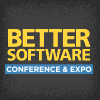Better Software Conference & EXPO 2005

PRESENTATIONS
|
Multi-Attribute Software Analysis
Although the methods for measuring individual quality characteristics of software (performance, functionality, etc.) are well known, few organizations have developed useful metrics to evaluate overall software quality. Recently, several large software organizations have found multi-attribute software analysis a valuable method to measure the progress of software development and to assess a product’s ship readiness. |

James McCaffrey, Volt Information Sciences, Inc. |
|
Negotiating the Defect Minefield for a Successful Product Release
Software success is strongly influenced by how you finish a project. For that, a special set of skills is required. Many projects fail in their endgame during testing, not because of the testing itself but because of the late discovery of defects and functional gaps that show the software as not viable. Join Robert Galen as he focuses on a set of high level practices and techniques that will help improve your management and steering within the endgame. Learn about a release framework with the right testing tempo and key milestones. |
|
|
Politics and Polemics in a Corporate Measurement System
Long, long ago in a company far, far away, Bill Curtis designed one of the largest software measurement systems ever deployed. Ultimately, it reported to senior management system measures that foretold the loss of one-half of the fifth largest company on earth. Covering all of the corporation's far-flung businesses, this measurement system highlighted the four critical factors that determine a project's fate and provided categories for normalizing and classifying the company's software. |

Bill Curtis, Borland Software Corporation |
|
Project Driven vs. People Driven Technical Management
Technical managers often find that their time is taken up by tasks that have the greatest urgency and those that seem to offer the most benefit. All too often our time is focused on project details to the detriment of building and retaining an excellent development team. Martin King's presentation illustrates people- and project-centered styles of management and the consequences of each. Learn the benefits of people-centered leadership and how to shift your style in this direction. |
|
|
Project Retrospectives
At the rate Web vulnerabilities are being discovered and exploited, the security industry cannot afford to continue trying to keep up with patches and fixes. Cross-site scripting, SQL injection, command injection-attacks like these result from vulnerabilities in inadequately designed or written code, creating opportunities for attackers to threaten privacy and steal data. The only way to truly eliminate these vulnerabilities is to address them at their origin-in the source code itself. |
|
|
Secure Software is a Management Issue, Too!
Development teams are entering a new era of software development. Security will play a critical role because traditional development practices are failing in the face of poor software quality and constant hacker attacks. As a manager, you are under pressure to write more secure, higher quality software while at the same time reducing operational costs. How can you incorporate the latest in software security development practices and stay within mandated budgets? |
|
|
Six Impossible Truths about Developing Software - All Before Breakfast
Alice laughed. "There’s no use trying," she said, "one can't believe impossible things." "I daresay you haven't had much practice," said the Queen. "When I was younger, I always did it for half an hour a day. Why, sometimes I've believed as many as six impossible things before breakfast." |

Tim Lister, Atlantic Systems Guild, Inc |
|
Software Factories: Hype or Hope for Real Advancement?
The new concept of Software Factories, as proposed by Microsoft, promises to elevate software development to the next level. Siemens is working with Microsoft to apply these approaches with the goal of improving product maintenance, quality, and time to market. Gunther Lenz explains the common elements and, more importantly, the differences between the Software Factories model and Model Driven Architecture (MDA), as proposed by the Object Management Group (OMG). |
|
|
Software Quality Metrics as Agents for Change
What is the purpose of software quality metrics and what values do they provide to the organization? What metrics not only report on and but also help drive changes and improvements in software quality? Based on his work at EMC, Jim Bampos discusses the metrics they use to predict software quality at ship time and the key quality questions to ask customers after ship. |
|
|
The Return on Investment for Finding Defects in Test
For testers, finding defects is a way of life. However, we usually don't reflect on what an undiscovered defect can cost a business or how much it costs to find defects late in development. Geoff Horne seeks to put real costs on both of these situations and looks at practical ways to reduce the costs of not finding defects. |

Geoff Horne, iSQA |


